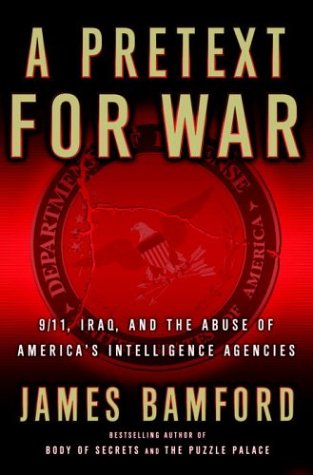
| ABOUT DV | CONTACT | SUBMISSIONS |
A Pretext for War
by Kim Petersen
www.dissidentvoice.org
October 26, 2004
First Published in
Shunpiking
![]()
Disinformation and Death
James Bamford's latest book, A Pretext for War, sifts through the information and events that led to 9-11 and lowered the threshold to the already planned invasions of Afghanistan and Iraq. In his easy-reading narrative Bamford weaves the information, draws the reader a sketchy profile of the protagonists and locations, and thereby lays forth a literary rendition that answers the five Ws.
Although Bamford's book isn't as overtly polemical as Michael Moore's movie Fahrenheit 9/11 there are overlaps. Bamford deals with the surreality of the Commander-in-Chief sitting perplexedly (as vividly depicted in Moore's film) for minutes while the US is under attack. At the moment of 9-11 Bamford finds that "the country had essentially become leaderless." Writes Bamford, "Disturbingly, the story George W. Bush often tells of his learning of the attacks cannot possibly be true."
Not only was the leadership of Bush missing but it appears so also was the courage of the war-president-to-be. Bamford didn't scrutinize Bush's contested National Guard record. Moore straightforwardly declares Bush to be a deserter.
Bamford doesn't stir up much controversy with how the events on 9-11 transpired. Although there are many oddities in the destruction of the World Trade Center buildings, such as the melted steel, perfect demolition-style collapse, and the fact that WTC building 7 also collapsed even though it wasn't hit, Bamford stays with the conventional picture.
Lacking in intelligence
While the disinformation central of the Office of Special Plans deserves special censure from Bamford, the other intelligence agencies do not escape criticism. There is reckless inter-agency competition and morale problems that adversely affect effective intelligence gathering and dissemination.
The war on terrorism is described as woefully inept, for which CIA chief George Tenet is singled out for criticism even though Bamford allows that the CIA is under-funded and understaffed in key positions. In the case of al Qaeda the human intelligence is lacking since it has never been infiltrated.
The US intelligence on terrorism is variously described as "bogus," "blatantly false," and "cooked up."
Why this came to be so is transparent from the order given by a CIA official to the staff: "[I]f Bush wants to go to war, it's your job to give him the reason to do so."
Fomenting the 9-11 attack
Bamford explores the network of groups fighting against US domination. He dispenses with the nonsense that terrorism stems from hatred of western freedoms. "It was equally clear that the reason for the attacks was the country's support for Israel and its occupation and treatment of the Palestinians."
Abhorrence of US government policy provoked aggrieved Arabs but the American public was not off the hook according to Osama bin Laden. "Regarding the American people, they are not exonerated from responsibility, because they chose this government and voted for it despite their knowledge of its crimes in Palestine, Lebanon, Iraq and in other places."
Bush had surrounded himself with a staunch Zionist circle and naturally the Washington orientation became increasingly more Israel friendly.
So it is unsurprising that the US would ignore the lamentations of bin Laden to cease their perfidy in the Arab world. Instead Bamford describes how the US has been drawn straight into the web that al Qaeda has weaved. Bamford does seem to accept that bin Laden is the person behind 9-11 although no conclusive evidence has been so far produced. In light of the slipshod intelligence, it is hard to swallow that people should readily accept such a say-so based on intelligence services brought into disrepute. Discussing bin Laden causes Bamford to reveal clearly his bias. How else can one interpret his description of bin Laden as "dripping with hatred"?
To be fair he also delves into the hatred that drives Bush. Bamford describes Bush's evident "raw hatred" for Saddam Hussein perhaps stemming from the purported Iraqi assassination attempt on his father -- also based on questionable intelligence, according to Bamford.
Bamford depicts a duel between Bush and bin Laden in which Bush fares poorly. "In the end, the only winner was Osama bin Laden. All along his goal, and that of his top leadership, was to draw the United States deeper and deeper into the sinkhole of a war in the Middle East."
Now the US and a sprinkling of coalition forces are mired in the sands of Iraq that they have rendered blood red -- an outcome brought about through the collusion of government and media and the insidious power of disinformation.
Kim Petersen is a writer living in Nova Scotia, Canada. He can be reached at: kimpete@start.no. This book review first appeared in Shunpiking.
Other Recent Articles by Kim Petersen
* Chomsky and
the Hopelessness of Lesser Evilism
* The
Importance of Being Careful of What One Wishes For
* The Great
Betrayal
* A
Desertion of Common Sense
* Putin's
Sheath
* Staring
into the Journalistic Abyss: Disinformation and Propaganda at the NY Times
*
Progressivism and the Corporate Olympics
* The
Futility of Revolving Warmonger Regimes
* The
Deadly Contradiction of Being John Kerry
* The Path
of Evil
* The
Importance of Solidarity
* Lessons
Not Learned
* A Tale of
Two Ethnic Cleansings
* The
Freedom Crusade (Part Three): Home of the Not-So-Free
* The
Freedom Crusade (Part Two): The Four Freedoms
*
The Freedom Crusade (Part One): Bush’s Mission
* The Progressive Paradox: Defining Viability
* The Shame
* The Wrong Direction
* The Pornography of War
* The Fairy
Tale of Liberation
* The
Lesser-of-Two Evils
* The
Etiology of Hate
